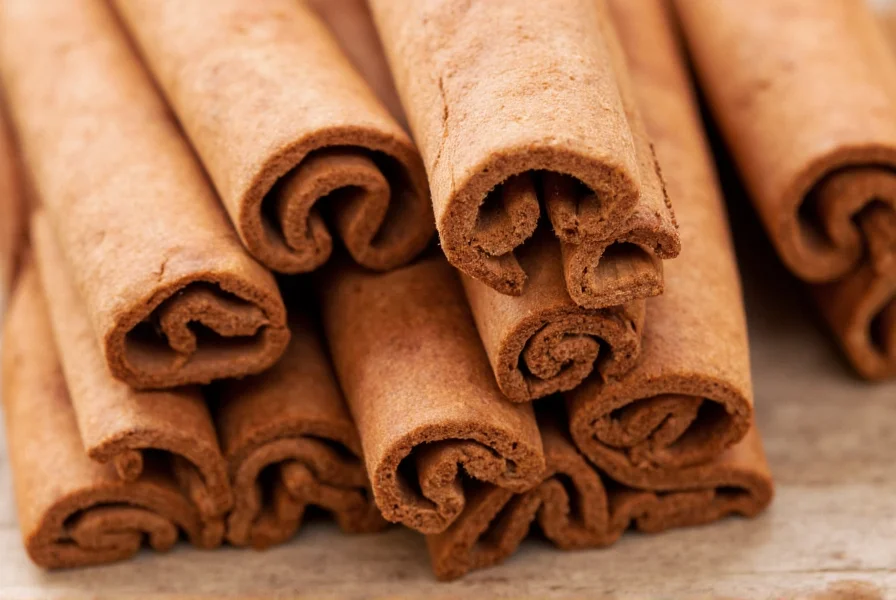Yes, you can safely eat small amounts of cinnamon stick, but with important precautions. While cinnamon sticks are edible and commonly used as a flavoring agent, consuming large quantities or swallowing whole pieces can pose choking hazards and potential health risks due to coumarin content, especially with Cassia cinnamon. Moderation is key for safe consumption.
Many people wonder is it safe to chew cinnamon sticks when they see these aromatic bark rolls in their spice cabinet. The short answer is yes—you can eat cinnamon sticks in moderation—but there are important considerations to understand before making them a regular part of your diet.
Understanding Cinnamon Stick Composition
Cinnamon sticks, also known as quills, are the dried bark of cinnamon trees. Unlike ground cinnamon, which processes the bark into powder, sticks maintain their fibrous structure. There are two primary varieties you'll encounter:
| Type | Characteristics | Coumarin Content |
|---|---|---|
| Cassia Cinnamon | Most common, stronger flavor, reddish-brown | High (up to 1% by weight) |
| Ceylon Cinnamon | Milder flavor, tan color, multiple thin layers | Very low (0.004% by weight) |
When considering can you swallow cinnamon sticks safely, the type matters significantly. Cassia cinnamon contains substantially higher levels of coumarin, a natural compound that can cause liver damage in sensitive individuals when consumed in large quantities over time.
Safety Considerations for Eating Cinnamon Sticks
While cinnamon sticks are technically edible, several safety factors should guide your consumption:
Choking Hazard
The rigid, fibrous nature of cinnamon sticks makes them difficult to chew completely. Small children and elderly individuals face particular cinnamon stick consumption risks due to potential choking hazards. Never give whole cinnamon sticks to young children.
Coumarin Content Concerns
According to the European Food Safety Authority, the acceptable daily intake of coumarin is 0.1 mg per kilogram of body weight. For a 150-pound adult, this translates to approximately:
- 1 teaspoon of Cassia cinnamon powder
- Or about 2-3 inches of Cassia cinnamon stick
Exceeding these amounts regularly could potentially lead to liver toxicity in sensitive individuals. Ceylon cinnamon presents significantly lower risk due to its minimal coumarin content.
Dental Considerations
Chewing hard cinnamon sticks can potentially damage teeth, especially if you have dental work or sensitive enamel. The abrasive nature of the bark may also contribute to gum irritation with frequent use.

How to Safely Consume Cinnamon Sticks
If you're interested in how to safely consume cinnamon sticks, consider these recommended methods:
Infusion Method (Safest Approach)
The safest way to enjoy cinnamon stick benefits is through infusion:
- Add 1-2 inches of cinnamon stick to hot water, tea, or other beverages
- Allow to steep for 5-10 minutes
- Remove the stick before drinking
This method extracts flavor and beneficial compounds while avoiding physical consumption of the tough bark.
Chewing Technique (With Caution)
If you prefer to chew cinnamon sticks directly:
- Limited to 1-2 inches maximum per day
- Chew thoroughly before swallowing
- Never swallow large pieces whole
- Consider Ceylon variety for lower coumarin exposure
Cinnamon Stick vs. Ground Cinnamon: Nutritional Comparison
Many wonder about the cinnamon stick vs ground cinnamon nutrition differences. While the nutritional profile remains similar, there are some important distinctions:
- Flavor intensity: Sticks provide more subtle, gradual flavor release
- Coumarin exposure: Ground Cassia cinnamon may deliver more concentrated coumarin
- Shelf life: Sticks maintain freshness longer than ground cinnamon
- Usage versatility: Ground cinnamon works better for baking; sticks excel in beverages
Special Population Considerations
Certain groups should exercise additional caution with cinnamon stick side effects:
Pregnant and Breastfeeding Women
While culinary amounts are generally considered safe, medicinal quantities should be avoided. Consult your healthcare provider before regular cinnamon stick consumption during pregnancy.
Individuals with Liver Conditions
Those with pre-existing liver conditions should limit Cassia cinnamon consumption and consider switching to Ceylon variety, which contains negligible coumarin.
People Taking Medications
Cinnamon may interact with certain medications, particularly those metabolized by the liver. If you take blood thinners, diabetes medications, or liver-affecting drugs, consult your physician before regular cinnamon stick consumption.

Practical Uses for Cinnamon Sticks Beyond Direct Consumption
If you're exploring health benefits of eating cinnamon sticks but want safer alternatives, consider these applications:
- Natural air freshener: Simmer sticks with citrus peels for a pleasant aroma
- Flavor infusion: Add to coffee grounds, rice pudding, or mulled wine
- Oral health: Chewing small pieces may temporarily freshen breath (spit out after)
- Craft projects: Use in decorative arrangements or potpourri
Recognizing Excessive Consumption Symptoms
Be aware of potential signs that you've consumed too much cinnamon:
- Mouth or throat irritation
- Nausea or stomach discomfort
- Increased heart rate
- In rare cases of significant coumarin exposure: liver tenderness or jaundice
If you experience concerning symptoms after consuming cinnamon sticks, discontinue use and consult a healthcare professional.
Conclusion: Enjoying Cinnamon Sticks Responsibly
While can you eat a cinnamon stick has a positive answer for most adults in moderation, understanding the proper consumption methods and limitations is essential for safety. The infusion method provides flavor benefits with minimal risk, while direct chewing requires careful portion control and thorough mastication. Choosing Ceylon cinnamon when possible reduces coumarin exposure concerns. As with any dietary addition, listen to your body and consult healthcare providers if you have specific health conditions or concerns.
Can you swallow cinnamon sticks whole?
No, you should never swallow cinnamon sticks whole. Their rigid structure poses a significant choking hazard. If consuming directly, chew thoroughly and limit to small pieces (1-2 inches maximum).
How much cinnamon stick is safe to eat daily?
For Cassia cinnamon, limit to 1-2 inches per day due to coumarin content. Ceylon cinnamon allows for slightly higher consumption (up to 3-4 inches), but moderation is always recommended. Those with liver conditions should consult their physician.
Is it safe for children to chew cinnamon sticks?
No, cinnamon sticks pose a choking hazard for children. The rigid bark is difficult for young children to chew properly. For flavoring children's foods, use minimal amounts of ground cinnamon instead, and always consult a pediatrician before introducing new spices to children's diets.
What are the benefits of chewing cinnamon sticks?
Chewing small pieces of cinnamon stick may temporarily freshen breath, provide mild antioxidant benefits, and offer a natural sugar-free flavoring option. However, these benefits can also be obtained more safely through infusion methods without the chewing risks.
Can cinnamon sticks help with blood sugar control?
Some studies suggest cinnamon may help with blood sugar regulation, but research specifically on cinnamon sticks (vs. ground) is limited. If using cinnamon for blood sugar management, consult your healthcare provider and monitor your levels carefully, as it may interact with diabetes medications.











 浙公网安备
33010002000092号
浙公网安备
33010002000092号 浙B2-20120091-4
浙B2-20120091-4